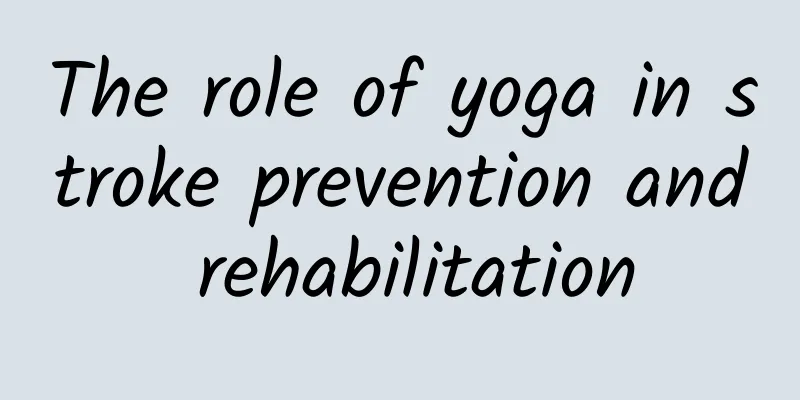The role of yoga in stroke prevention and rehabilitation

|
What is a stroke? Stroke refers to a series of neurological dysfunctions caused by cerebral ischemia or hemorrhage due to cerebrovascular disease. According to the pathogenesis, stroke can be divided into two categories: ischemic stroke and hemorrhagic stroke. Ischemic stroke refers to local ischemia and hypoxia of the brain due to cerebral atherosclerosis, thrombosis, embolism and other reasons, causing nerve cell damage or death. Hemorrhagic stroke refers to intracerebral or subarachnoid hemorrhage due to hypertension, arteriovenous malformation, cerebral aneurysm and other reasons, causing nerve cell compression or destruction. What are the dangers of stroke? Stroke is a common neurological disease and one of the leading causes of death and disability worldwide. According to statistics, about 15 million people suffer from stroke each year, of which about 6 million die and about 5 million become disabled. Stroke not only threatens the patient's life, but also brings huge economic and psychological burdens to the patient and his family. Stroke may lead to the following sequelae: Motor dysfunction: Due to damage to the area of the brain that controls muscle movement, patients may experience limb paralysis, abnormal muscle tone, joint stiffness, imbalance and other problems, affecting their daily life and work ability. Sensory dysfunction: Due to damage to the area of the brain that receives and processes sensory information, patients experience reduced or lost sensations such as touch, temperature, pain, and position, increasing their risk of injury and infection. Cognitive dysfunction: Due to damage to the areas of the brain responsible for cognitive activities such as thinking, memory, judgment, and attention, patients experience problems such as decreased cognitive ability, disorientation, memory impairment, and executive dysfunction, which affect their learning and social adaptability. Language dysfunction: Due to damage to the area of the brain responsible for language comprehension and expression, patients may experience aphasia, speech disorders, dyslexia, writing disorders and other problems, which affect their communication and interaction abilities. Swallowing dysfunction: Due to damage to the area of the brain that controls swallowing, patients experience problems such as difficulty swallowing, aspiration, coughing, and choking, which affect their nutritional status and respiratory health. What is rehabilitation therapy? Rehabilitation therapy refers to a comprehensive medical service that uses various methods and means to help stroke patients recover or improve their impaired functions and improve their quality of life. The purpose of rehabilitation therapy is to promote functional recovery and independence of patients and to achieve early recovery as long as the patients can tolerate it. Rehabilitation therapy includes: Motor function training: Through passive exercise, active exercise, balance training, standing and walking training and other methods, the patient's muscle strength, muscle endurance, joint mobility, coordination, etc. are enhanced to improve the patient's motor function. Sensory function training: Through stimulation of touch, temperature, pain, sense of position, etc., the patient's sensory nerve regeneration or reorganization is promoted, and the patient's sensory function is improved. Cognitive function training: Through cognitive tasks such as memory, attention, judgment, and reasoning, the patient's cognitive ability and cognitive function are improved. Language function training: Through listening, speaking, reading, writing and other language tasks, the patient's language comprehension and expression ability is improved, and the patient's language function is improved. Swallowing function training: Improve the patient's swallowing ability and swallowing function through oral care, food selection, posture adjustment, swallowing movement exercises and other methods. What are the benefits of practicing yoga? Yoga is an ancient form of physical exercise originating from India, which mainly includes three aspects: Asana, Pranayama and Meditation. Practicing yoga has the following benefits: Regulating blood pressure and heart rate : Yoga can help people relax their body and mind and reduce stress response through breathing and meditation, thereby lowering blood pressure and heart rate and preventing risk factors for stroke such as hypertension and heart disease. Enhance vascular elasticity : Yoga can help people increase blood circulation through postures and breathing techniques, promote the secretion of vasodilator factors such as nitric oxide by endothelial cells, thereby enhancing vascular elasticity and preventing risk factors for stroke such as arteriosclerosis and thrombosis. Improve metabolic levels : Yoga can help people consume excess energy and regulate the endocrine system through postures and breathing techniques, thereby improving metabolic levels and preventing risk factors for stroke such as obesity, hyperlipidemia, and hyperglycemia. Increase neuroplasticity : Yoga can help people increase the density of gray matter in the brain and promote the new birth or reorganization of neurons through meditation and breathing techniques. The role of yoga in stroke rehabilitation Yoga can not only prevent stroke, but also help stroke patients recover. The role of yoga in stroke rehabilitation is mainly reflected in the following aspects: Promote nerve function recovery: Yoga can help patients relax their brains, increase blood oxygen supply, promote neuronal regeneration or reorganization, and increase neural plasticity through meditation and breathing methods, thereby promoting nerve function recovery. Strengthening motor function training: Yoga can help patients enhance muscle strength, muscle endurance, joint mobility, coordination, etc. through posture and breathing methods, and improve patients' motor function. Yoga can also be combined with conventional exercise training in the rehabilitation department, such as handshake, fisting, fingering, bridge exercise, standing and stepping training, etc., to improve the training effect. Improve sensory dysfunction: Yoga can help patients increase sensory stimulation through posture and breathing methods, promote sensory nerve regeneration or reorganization, and improve patients' sensory function. Yoga can also be combined with conventional sensory training in the rehabilitation department, such as stimulation of touch, temperature, pain, and position, to improve the training effect. Improve cognitive function: Yoga can help patients improve their attention, memory, judgment, reasoning and other cognitive abilities through meditation and breathing techniques, and improve patients' cognitive functions. Yoga can also be combined with conventional cognitive training in the rehabilitation department, such as memory, attention, judgment, reasoning and other cognitive tasks, to improve the training effect. Improve language dysfunction: Yoga can help patients relax their language centers through meditation and breathing techniques, increase blood flow to the language area, promote the regeneration or reorganization of the language area, and improve the patient's language function. Yoga can also be combined with conventional language training in the rehabilitation department, such as listening, speaking, reading, writing and other language tasks, to improve the training effect. Improve swallowing dysfunction: Yoga can help patients relax throat muscles, increase blood flow to the throat area, promote regeneration or reorganization of the throat area, and improve swallowing function through meditation and breathing. Yoga can also be combined with conventional swallowing training in the rehabilitation department, such as oral care, food selection, posture adjustment, swallowing movement exercises, etc., to improve the training effect. How to choose the yoga that suits you? If you are a stroke patient or at risk of stroke, you can choose some simple, gentle and safe yoga, such as Hatha Yoga, Yin Yoga, Meditation Yoga, etc. These yogas can help you relax your body and mind, regulate blood pressure and heart rate, enhance vascular elasticity, improve metabolic levels, increase neuroplasticity, and promote stroke prevention and recovery. You can also choose some postures, breathing methods and meditation methods that suit you according to your physical condition and preferences, and conduct personalized yoga exercises. Before practicing yoga, you should consult your doctor and therapist to understand your physical condition and limitations and avoid doing some movements that may be harmful to you. When practicing yoga, you should pay attention to the following points: Choose a quiet, comfortable, ventilated environment, wear loose, comfortable clothes, and use a professional yoga mat or blanket. Drink some warm water before and after practice to keep your body hydrated and avoid dehydration. Do not eat too much or too little before or after practice to avoid affecting digestion and blood circulation. When practicing, pay attention to the rhythm and depth of your breathing. Do not hold your breath or exert excessive force to avoid causing dizziness, nausea, and other discomforts. When practicing, adjust the amplitude and speed of movements according to your ability and feeling. Do not force or exceed your limits to avoid causing muscle or joint injuries. When practicing, stay focused and relaxed, and don't be distracted or nervous, so as not to affect the effect and experience. After exercise, do some stretching and relaxation exercises to relieve tension and fatigue in muscles and joints. |
Recommend
[2023 "Science Popularization China Youth Star Creation Competition"] Human Model Worker - Liver Repair Manual
The author of the winning works of the 2023 "...
What to do if your menstruation is irregular
Nowadays, it is very common for women to have irr...
How to learn reading analysis well? What should you pay attention to when doing reading analysis questions in the first grade?
Chinese reading comprehension questions test stud...
What is there in Mogao Grottoes? What is the detailed introduction of Mogao Grottoes?
Our country is vast and rich in resources. We hav...
Small breasts to big breasts
The way to turn small breasts into big breasts re...
Normal blood pressure range for adult women
Most women have low blood pressure because they h...
What determines placental maturity?
The histological changes of the embryo are the ba...
Mobile medical care is becoming increasingly popular, but it will take time to subvert traditional medical care
The device checks Trellini's blood pressure s...
Pictures of genital hair removal
With the development trend of medicine today, peo...
Can I drink milk tea during early pregnancy?
The fetus is not completely stable in the early s...
What are the clinical manifestations of chronic cervicitis?
Many types of gynecological diseases are now high...
What do you think is the difference between healthy concentrated juice and fruit?
Many places have entered summer early this year. ...
The ovulation test paper changes from strong positive to weak positive. Does it mean ovulation?
In order to increase the chance of pregnancy, cou...
What injection should I take for less menstruation
The amount of menstrual flow in women is also an ...
How to give birth quickly in late pregnancy
The arrival of pregnancy means that delivery is i...









